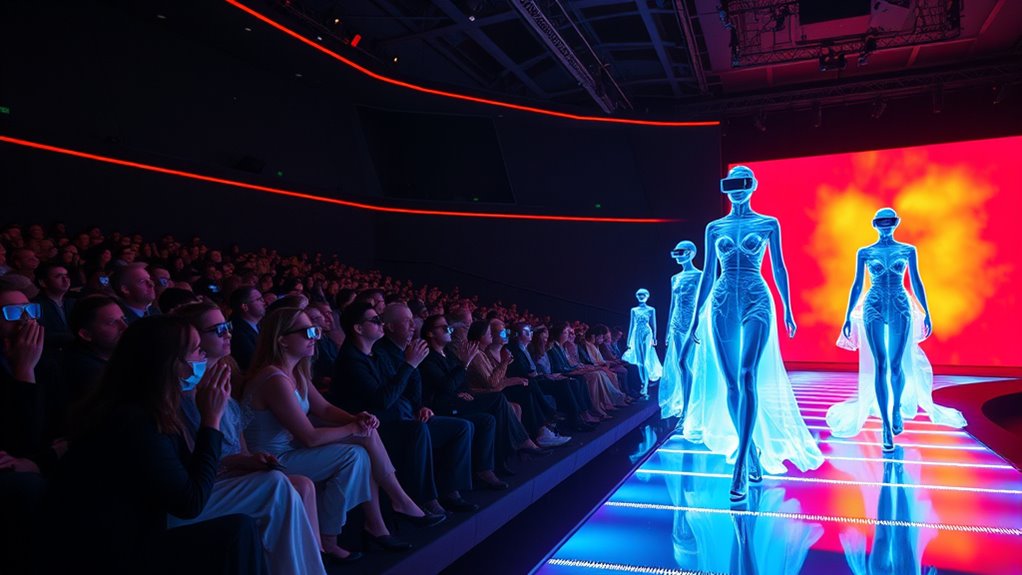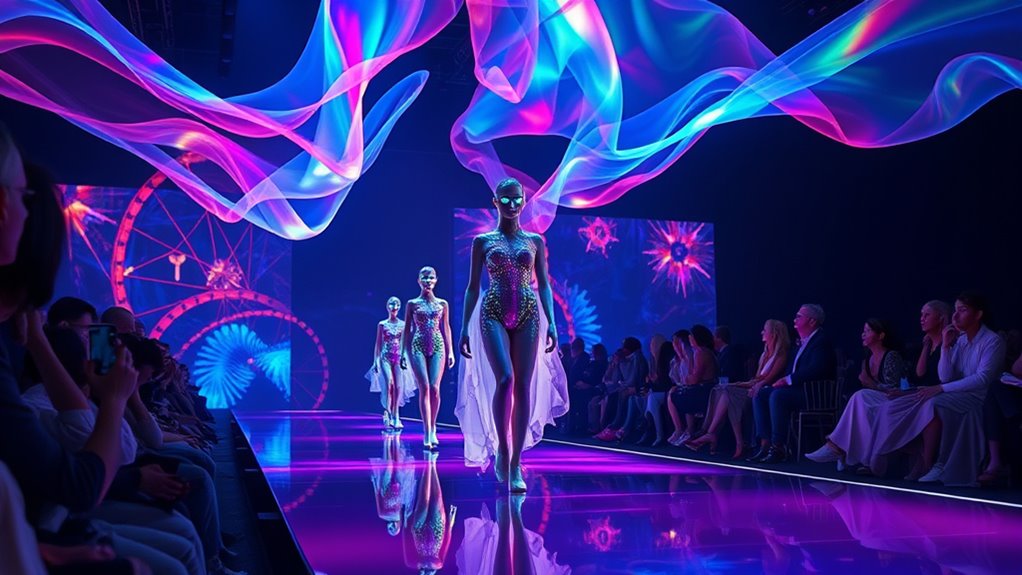AI is transforming how you experience fashion shows by turning them into interactive, immersive events accessible from anywhere. It uses digital runways, virtual models, and realistic 3D environments to create engaging displays that break geographical barriers. You can even customize designs, try virtual try-ons, and interact with virtual models, making the experience active rather than passive. If you want to uncover how AI makes these innovations possible, keep exploring the possibilities.
Key Takeaways
- AI enables virtual, immersive runway experiences accessible globally, eliminating physical venue constraints.
- Real-time customization and augmented reality apps allow viewers to actively participate and try designs virtually.
- AI-driven avatars promote diversity and inclusivity, representing various body types, ethnicities, and abilities.
- Data collection and analysis optimize show content, enhance audience engagement, and inform future collections.
- AI reduces costs and environmental impact by supporting sustainable practices and minimizing material waste.

Artificial Intelligence is revolutionizing fashion shows by turning them into interactive and immersive experiences that reach audiences worldwide. Instead of sitting through traditional runway presentations, you now get to experience shows that are dynamic, customizable, and accessible from anywhere. AI-powered virtual runways and digital models eliminate the need for physical venues, breaking down geographical barriers and making high-end fashion more inclusive. With advanced 3D modeling, AI creates realistic virtual garments and models, allowing you to see designs in detail without waiting for physical prototypes. These digital runways transform the audience experience, offering immersive environments that captivate viewers and make fashion shows more engaging than ever before. Additionally, AI’s capacity for content generation enables the creation of entirely new visual narratives, pushing the boundaries of creative expression in fashion. This technology also facilitates real-time customization, allowing for instant adjustments to designs based on audience reactions or designer input. You can participate directly in these shows by customizing designs in real time. AI enables you to tweak colors, fabrics, or styles during live presentations, giving you a sense of ownership and involvement. Augmented Reality (AR) apps take this a step further, letting you virtually try on outfits from the comfort of your home. This interactivity increases engagement, making viewers feel like active participants rather than passive spectators. You can even interact with virtual models and environments, asking questions or exploring different styling options. This level of participation fosters a deeper connection to the brand and the collection being showcased. Moreover, AI-driven virtual platforms are cost-effective, reducing expenses related to travel, venue rentals, and physical production. Smaller brands can now compete on a global stage, reaching audiences without the logistical and financial hurdles traditional shows impose. Audience feedback is also integrated seamlessly; AI gathers data on viewer preferences and interactions, helping designers refine their collections and presentation strategies for future shows. This constant loop of feedback and adjustment ensures that each show becomes more tailored and impactful. Additionally, AI security measures are implemented to safeguard sensitive design data and protect user interactions from cyber threats, ensuring a secure experience for all participants. In the pursuit of sustainability, AI-powered virtual shows significantly reduce the environmental impact of fashion events, exemplifying a shift towards eco-friendly practices. In addition to transforming how shows are experienced, AI advances sustainability efforts within the fashion industry. Virtual presentations cut down on material waste, energy consumption, and carbon footprint associated with travel and large-scale events. By predicting demand and optimizing supply chains, AI minimizes overproduction and resource wastage, supporting more sustainable practices. AI-generated avatars representing diverse body types, ethnicities, and abilities promote inclusivity, challenging conventional beauty standards and fostering representation. Incorporating advanced data analysis helps designers better understand consumer preferences and tailor collections to meet diverse needs, further democratizing fashion. Accessibility features embedded into these digital platforms ensure that viewers with disabilities can participate fully, further democratizing fashion.
Frequently Asked Questions
How Does AI Personalize Fashion Show Experiences for Individual Viewers?
You might wonder how AI personalizes your fashion show experience. It analyzes your preferences, body type, and browsing data to offer tailored recommendations and styling tips. AI creates custom avatars and virtual try-ons so you can see how outfits fit you. It also adjusts show content based on your reactions, suggesting similar designs and eco-friendly options, making your experience unique, engaging, and perfectly suited to your style.
What Ethical Considerations Arise From Ai-Generated Fashion Content?
When it comes to AI-generated fashion content, you need to consider vital ethical concerns. Bias breeds by relying on limited data, risking stereotypes and excluding diversity. Transparency builds trust, while accountability keeps creators responsible. Privacy protection safeguards customer data, and legal safeguards defend intellectual property. You must prioritize fairness, fairness, and freedom from favoritism, ensuring that AI fashion content promotes inclusivity, respects privacy, and complies with legal standards—all while fostering trust and transparency in the fashion industry.
Can AI Predict Future Fashion Trends Accurately?
You might wonder if AI can truly predict future fashion trends accurately. The answer is yes, AI uses vast data, social media insights, and real-time analysis to forecast trends with high precision. It identifies patterns and consumer preferences quickly, helping you stay ahead. While not perfect, AI’s ability to adapt and analyze constantly changing data makes it a powerful tool for predicting fashion’s next moves effectively.
How Accessible Is AI Technology for Small Fashion Brands?
Think of AI as the secret ingredient in a chef’s pantry—more accessible than you might think. For small fashion brands, AI is becoming increasingly within reach thanks to no-code tools, user-friendly platforms, and growing industry support. While costs and expertise pose challenges, innovations are making AI more affordable and easier to implement. With some effort, you can harness AI’s power to boost creativity, efficiency, and competitiveness in your business.
What Are the Limitations of AI in Creating Authentic Fashion Presentations?
You should know that AI faces several limitations in creating authentic fashion presentations. It struggles with capturing human emotions, complex poses, and cultural nuances, often producing overly idealized images. Its reliance on existing data can lead to biases, and it may lack originality, making it hard to truly innovate. Additionally, ethical concerns like stereotypes and representation need careful management, so human insight remains essential for genuine, meaningful fashion displays.
Conclusion
So, next time you marvel at a futuristic runway, remember—it’s probably just AI working its magic behind the scenes. Who needs human designers or models when algorithms can craft a show that’s more interactive than your last Tinder date? Truly, fashion’s future is in silicon and code, promising a spectacle that’s as unpredictable as your Wi-Fi connection. Cheers to the end of human creativity—after all, what could possibly go wrong?











